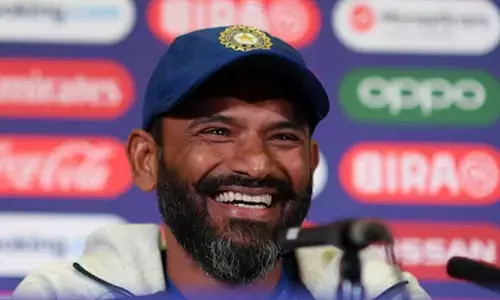India’s growth leaping in wrong direction

Recently, Nobelwinning economist Amartya Sen said that despite being the fastestgrowing economy, India has taken a quantum jump in the wrong direction since the BJP came to power in 2014 The message embedded in Sens speech is that during the previous regime proper attention was not given on social sectors, which led to visible prominence of backwardness in India
Recently, Nobel-winning economist Amartya Sen said that despite being the fastest-growing economy, India has taken a ‘quantum jump in the wrong direction’ since the BJP came to power in 2014. The message embedded in Sen’s speech is that during the previous regime proper attention was not given on social sectors, which led to visible prominence of backwardness in India.
But under the present BJP government, things have gone further awry due to lack of attention to social sectors and India is getting further backward. According to him, twenty years ago, of the six countries in this region — India, Pakistan, Bangladesh, Sri Lanka, Nepal and Bhutan – India was the second best after Sri Lanka, but now, it is downgraded to second worst. Pakistan has managed to shield us from being the worst.
No doubt, public investment in social infrastructure such as health, education, which is considered critical to economic progress, has been dipping during present BJP government. The Economic Survey also acknowledges the unimpressive investment in social infrastructure too. According to Economic Survey 2017-18, in 2012-13, education expenditure (Centre and States combined) was 3.1 per cent of the GDP. It fell to 2.8 per cent in 2014-15 and registered a further decline to 2.4 per cent in 2015-16 before marginally recovering to 2.6 per cent in 2016-17.
It means, it is a sheer delusion to believe that expenditure on education will touch 6 per cent of GDP as recommended by Kothari Commission and envisaged by successive central governments. India’s education expenditure is abysmal when compared with UK (6 per cent), Denmark (6.5 per cent), New Zealand (6.4 per cent) , Korea (6.3 per cent) , Canada (6.2 per cent), Norway( 6.2 per cent), US (6.2 per cent) ,Cuba (12.9 per cent). Even the country is behind its neighbouring countries such as China (4 per cent), Pakistan (2.8 per cent), Sri Lanka (3.5 per cent), Nepal (3.7 per cent ). Only Bangladesh (2.5 per cent) is behind India.
Looking at central spending in education as a share of the GDP, the trend clearly plummeted from 0.63 per cent in 2013-14 to 0.55 per cent in 2014-15, 0.50 per cent in 2015-16 and further to 0.49 per cent in 2016-17, and is projected to be 0.47 per cent in the budgeted estimates of 2017-18.
What is major failure of this government is that, compared to 2013-14, the last year of UPA, when education got 4.57 per cent of total budgetary outlay, there has been steady decline to 4.14 per cent in 2014-15, 3.75 per cent in 2015-16 and further to 3.65 per cent in 2016-17 before marginally increasing to 3.71 per cent in budgeted estimates of 2017-18.
Similarly, India’s health sector is in disarray. India ranks awfully at 145th among 195 countries in terms of healthcare access and quality in 2016, as assessed in a Global Burden of Disease study published in The Lancet. It is behind its neighbours like China, Bangladesh, Sri Lanka and Bhutan.
India’s health expenditure as a proportion of GDP is one of the lowest in the world. India's public health budget (Centre plus States) is nearly 1.4 per cent of GDP, which is abysmal when compared with US (8.3 per cent), South Africa (8.7 per cent), OECD members (7.7 per cent), and world average of 5.95 per cent in 2014. India is only ahead of Pakistan (0.9 per cent) and Bangladesh (0.8 percent) in health expenditure and countries like China (3.1 percent) and Sri Lanka (2 per cent) are way ahead of it in facilitating health care to the citizens.
Dismal health expenditure figure has triggered massive pressure on the existing health infrastructure. India’s health care system is one of the most privatised in World and around 70 per cent of health expenditure is borne by patients which drags around 5 crore people to poverty trap every year. The number of doctors per 1000 populations is only 0.62 in India as against WHO norm of one doctor per 1000.
The decline in health and educational expenditure has resulted in decline in development despite high growth. It is a matter of compunction that that India has the largest number of malnourished kids in the world and home to the highest number of hungry people in the world, at 194 million, surpassing China, according to United Nations annual Hunger Report 2014-15 .Around 30 crore people are languishing under poverty.
There is no meaning of growth if it does not lead to development. While development is the goal, economic growth is the medium to achieve that goal. Despite high growth, India is placed appallingly in all social international indices even behind neighbouring countries. India is placed awfully at 131 in Human Development Index 2017; 100th in Global Hunger Index 2016, 122 in World Happiness Index 2017.
What is distressing is that India is ranked awfully at the 62nd place among 103 emerging economies on an Inclusive Development Index, much below its neighbouring countries such as China’s 26th position, Nepal (22), Bangladesh (34), Sri Lanka (40), and Pakistan (47). All those corroborate Sen’s views that India is getting backward. Undeniably, mere economic growth cannot help in achieving development unless accompanied by government’s action. But proponents of neo-liberalism are always opposed to government’s action and intervention.
By: Dr Santosh Kumar Mohapatra
(The author is a financial economist)














